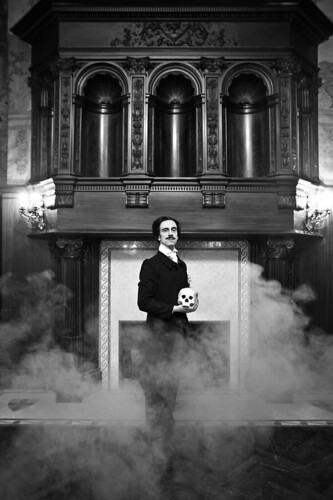The largely hyped-up interactive experience fails to capture the spookiness and mystery behind Edgar Allen Poe’s fiction.

Imagine yourself walking down a dark and dreary hallway, your footsteps almost ghostlike, muffled by the dust and grime of a century’s decay. An eerie, rattling wind rushes through a broken window at the end of the hall. A rusty door hinge creaks, and flames flicker as the wax drips and crusts like blood to the candelabra on the wall. As you approach the window, you see a doorway, a portal into a treacherous black abyss. A deathly whisper beckons you to it, and curiosity trumps logic as you slowly obey. All senses are surrendered as you saunter into the room, unaware of what demons lie beyond.
Advertised as “an immersive, multiple-sensory experience,” Brat Productions’ Haunted Poe brings some of Edgar Allen Poe’s greatest stories (i.e. Masque of the Red Death, The Raven, The Tell-Tale Heart, The Black Cat) to a new level of theatrical display. Instead of simply telling each of Poe’s ghost stories, the creative team decided to literally place the audience in the middle of them.
Brat used a 10,000 square foot warehouse in South Philly to create the multi-roomed haunted house. A theatergoer, designer and performer, and of course as an avid Poe fan, I couldn’t resist the trip down to South Water and Jackson streets to see its opening preview.
Unfortunately, the only scary part about the evening was the admission price, $15 – and that was only for a preview. Though brilliant in concept, the production was subpar in execution. As I ascended the steps to the second level of the warehouse, my anticipation grew. But as I rounded the corner to where the haunted house was located, my instincts said I might be sorrowfully disappointed.
One would expect a cavernous, cobwebbed foyer out of a 1930s horror film, but instead, there was a harshly lit open space, complete with exposed overhead ductwork.
The audience was ushered into the attraction and entered the first of a maze of rooms. This “prologue” to the rest of the haunted house was a cleverly devised and highly entertaining puppet show that provided seven minutes of insight to Poe’s life. The history was remarkably accurate, complete with a sickly comical depiction of tuberculosis in the form of the puppets’ heads popping off.
From there, we were ushered into what should have been a truly haunting experience but ended up being a convoluted mix of predictability and tediousness. While the acting, makeup and costumes were all very well done – with the exception of the alien-like mask in Masque of the Red Death – there were negative aspects of the production that ruined the mood and cancelled out many of the positive ones.
A warehouse seemed like a good idea, but its high ceilings became a disadvantage to Brat’s overall design. The walls of the haunted house were about 9 feet high, leaving the top of each “room” open. As a consequence, sound carried, and all the stories could be heard simultaneously.
The other downfall to using an open-ceiling design was that the audience got to see even more of the pipelines and ductwork of the warehouse. While most of the scenery served its purpose, the overall visual effect was less than extraordinary.
Nathan Schlegel, a sophomore lighting design major at the University of the Arts, said the use of a smoke machine in each room might have contributed to Haunted Poe’s overall design. The smoke machine, known as a hazer, would have provided a mask for the contemporary warehouse ceiling, a medium through which stage lighting could travel and an eerie transition device for the audience.
So is this the typical bloody-zombie-coming-at-you-with-chainsaw scare? No, and it wasn’t intended to be. The beauty of Haunted Poe is that it is an interactive production, requiring thought and active listening. Its array of professional actors attempts to penetrate the human psyche and capture the imagination.
Unfortunately, my psyche was too distracted by the visual effects and the sound of overlapping stories. Perhaps in this case, simplicity is best. Maybe using less lighting might have created a more haunted setting. The creative team might have done a better job at capturing its audience had it not incorporated film as a story-telling medium. Heavier reliance on actors in these instances would have exceeded my expectations.
Despite some unsatisfactory design choices, the imminent threat of a character popping out from a secret doorway was enough to keep me mildly on edge for the duration of the performance.
One saving grace of the piece was its story-telling, which is, after all, why Poe wrote in the first place – to have his stories told. Beyond that, Haunted Poe was mediocre and fell short of the bar it set for itself.
You might be better off reading the stories for yourself this year and allowing your mind to conjure its own blood-curdling terrors.
Matt Flocco can be reached at matthew.flocco@temple.edu.


As an aspiring journalist, perhaps Matt should become aware of the fact that show previews are still rehearsals for the company. Professional writers are not allowed to review a show until it is out of preview and they have seen an actual performance.